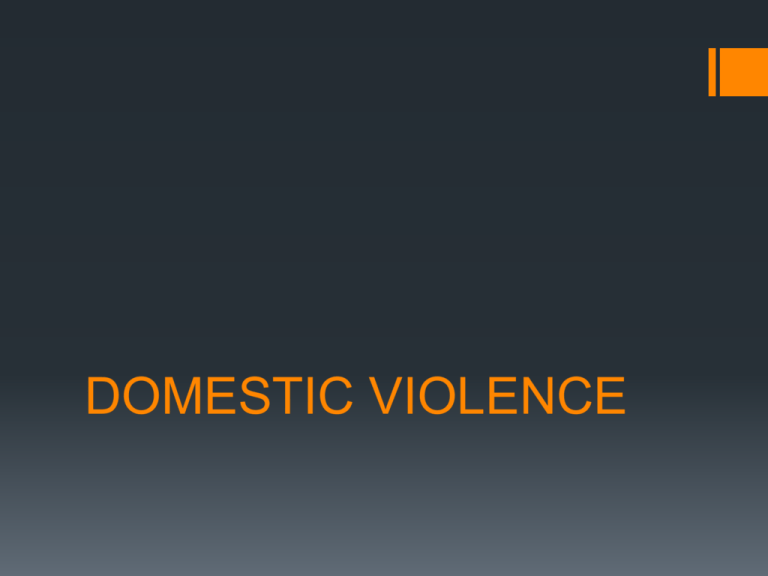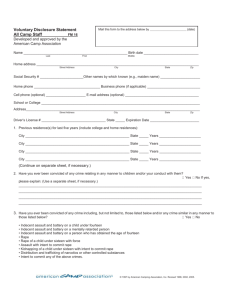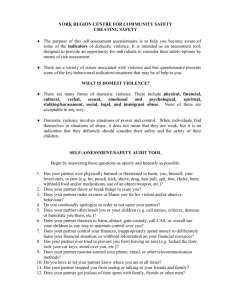
DOMESTIC VIOLENCE
9
Violence Against
Women
Olds’ Maternal-Newborn Nursing & Women’s Health Across the Lifespan, Ninth Edition
Michele Davidson • Marcia London • Patricia Ladewig
Violence Against Women
Endemic in society
Two of the most common forms of violence
are:
Intimate partner violence (IPV)
Sexual assault
Declined 1993 to 2008 (9.4/1000 female ages 12 or
older – 4.3).
Underreported (fewer than half reported to the police).
The cost o violence includes but not limited to: medical
care, mental health services, lost productivity.
Controllers are more likely to be assaultive, sending
partner to emergency
Health care providers can play critical role in
identification and reducing violence, even prevent
homicide.
Role of Healthcare Providers and
Organizations
1985 – Surgeon General identified IPV as
epidemic public health issue
1990 – Joint Commission on Accreditation
of Healthcare Organizations (JCAHO)
mandated the development of case
identification and treatment protocols
Role of Healthcare Providers and
Organizations (cont’d)
1991 – (revised I 2000) American Nurses
Association (ANA) position statement advocated
education for nurses in identification, prevention
and research on violence.
Healthy People 2010 ( national health promotion
and disease prevention project) – national priority
Nurses play a key role in developing and
evaluating innovative health care practices aimed
at reducing violence.
In 1993, the UN Declaration on the Elimination of
Violence against Women offered the first official
definition of the term “Gender-based Violence”:
“Any act of gender-based violence that results in,
or is likely to result in, physical, sexual or
psychological harm or suffering to women,
including threats of such acts, coercion or arbitrary
deprivations of liberty, whether occurring in public
or in private life.
Historic Factors
Patriarchal societies
Women as property of husbands
“Keep her in line”
Male dominance
Rape – act of aggression against another
man
Domestic Violence
Pattern of coercive behaviors and methods
used to gain and maintain power and
control by one individual over another in an
adult intimate relationship
Among heterosexual couples, estimates
indicate at least 95% of all DV the
perpetrators are men
Intimate partner violence (IPV) refers to any
behavior within an intimate relationship that causes
physical, psychological or sexual harm to those in
the relationship.
In USA 1 in 4 women will experience DV.
Forms vary but typically described as :
Physical abuse
Sexual abuse
Psychological abuse
Threat to physical or sexual abuse
In JORDAN
Thirty-four percent of ever-married women age 15-49 have experienced
physical violence at least once since age 15, and 13 percent experienced
physical violence within the 12 months prior to the survey.
Nine percent of ever-married women age 15-49 report having
experienced sexual violence at least once in their lifetime.
Overall, 32 percent of ever-married women age 15-49 report ever having
experienced emotional, physical, and/ or sexual violence from their
spouse, and 22 percent report having experienced one or more of these
forms of violence in the past 12 months. •
Among ever-married women who had experienced spousal violence
(physical or sexual) in the past 12 months, 30 percent reported
experiencing physical injuries (DHS, 2012)
Psychological Abuse
Emotional abuse: put down, feel bad about self
Isolation: controlling whom to see and where to go,
jealousy to justify acts
Obfuscation: denying responsibility, blaming,
distorting the truth
Using others: use children against her, threat to
take children, use religion to control her
Male privilege: like servant, rigid male female
roles, making all decisions
Economic abuse: preventing from getting job,
control her money
Coercion threats: threats to harm her family, to
commit suicide, to drop charges
Intimidation: making her afraid by looks and
gestures, display weapons, yelling, stalking her
Physical Abuse
Pushing
Shoving and slapping
Hitting with fist or object
Kicking
Choking
Threatening with gun or knife
Figure 9-1 Homicides of intimate partners by gender of victim, 1993–2007. Source: Catalano, S., Smith, E., Snyder, H., & Rand,
M. (2009). Female victims of violence. Bureau of Justice statistics: Selected findings. Retrieved from
http://bjs.ojp.usdoj.gov/content/pub/pdf/fw.pdf
Sexual Abuse
Forces or tries to force sex
Forced use of objects
Forcing a women to have sex with
someone else
Figure 9-2 The power and control wheel. Source: Adapted from the Domestic Abuse Intervention Project, Duluth,
Minnesota.
Consequences of Abuse
Consequences can be profound
Physical consequences
Adverse psychological consequences
Post-traumatic stress disorder (PTSD),
depression, anti social behavior, anxiety, suicidal
attempts, low self esteem, fear of intimacy.
Social consequences: restricted access to service,
isolation fro social network, strained relationship
with HCP and employers.
Factors Contributing to Violence
Childhood experiences: those who witness or
bear abuse more likely to be abusive
Male dominance in the family: patriarchal
Marital conflict:
Unemployment/low socioeconomic status: it
occurs in all SES, however it is more common in
families with low income, unemployment.
Traditional definitions of masculinity: telling
boys to be tough, not to shy of violence, to hide
feelings.
Common Myths
Battering occurs in small percentage of
population: underreported
Abused women provoke men to beat them:
individually responsible for their act
Alcohol, drug abuse cause battering: shift
responsibility, will not stop violence if
stopped substance
Battered women can easily leave situation:
leaving is easier said than done
Domestic violence – low-income, minority
issue: it occurs among all sectors of
society
Battered women safer when pregnant:
battering may occur first time during
pregnancy or may escalate in intensity
Cycle of Violence
Walker (1984) developed theory
Tension-building phase
Acute battering incident
Tranquil phase (honeymoon period)
Common Characteristics of Batterers
Batterers come from all racial, ethnic, SES,
religious and educational backgrounds
Insecurity and inferiority
Powerlessness and helplessness
Male supremacy
Emotional immaturity
Aggression – expression of overwhelming feelings
through violence
May have been abused
Common Characteristics of Batterers
Nursing Care Management
Women enter healthcare system in many settings
May have no visible injuries
May return to abusive situations
Nursing Assessment and Diagnosis
Universal screening advocated
Need comprehensive education, training
Four basic screening questions
Within last year, have you been hit...?
Since you’ve been pregnant, have you been hit...?
Within last year, has anyone forced you...?
Are you afraid of anyone at home or an ex-partner?
Signs of Abuse
Neurologic
Gynecologic
Obstetric
Gastrointestinal
Musculoskeletal
Psychiatric
Constitutional
Signs of Abuse (cont’d)
Trauma
Other signs
Cues of Abuse
Hesitation in providing detailed information about injury
Inappropriate affect
Defensive injuries
Delayed reporting of symptoms
Pattern of injury consistent with abuse
Inappropriate explanation for injuries
Cues of Abuse (cont’d)
Vague complaints without accompanying pathology
Lack of eye contact
Signs of increased anxiety in presence of possible batterer
Assessment
Arrange for private place for interview
Determine sense of pattern of abuse
Information about strengths support system
Document extent of injuries
Use woman’s exact words
Describe incident
Figure 9-3 Abuse assessment screen. Source: Developed by the Nursing Research Consortium on Violence and
Abuse. Reprinted from the Web site of the Nursing Network on Violence Against Women International
(http://www.nnvawi.org).
Figure 9-3 (continued) Abuse assessment screen. Source: Developed by the Nursing Research Consortium on
Violence and Abuse. Reprinted from the Web site of the Nursing Network on Violence Against Women International
(http://www.nnvawi.org).
Culturally Competent Care
Lack of ability to seek help outside the family
Language – barrier to communication
Inaccurate perceptions of legal system
Potential threat of deportation
Religious beliefs conflicting with legal remedies
Cultural stereotyping
Nursing Diagnoses
Risk for Powerlessness
Related to feelings of worthlessness
Readiness for Enhanced Knowledge
Information about community resources to assist battered women
Related to expressed desire to learn about alternatives
Nursing Plan and Implementation
Reestablish feeling of control
Supportive counseling, reassurance
Assist exploration of options, resources
Allow to make own decisions
Health promotion education – exit plan
Community-Based Nursing Care
Inform woman of services available
Network of community agencies
Needs of Abused Women
Medical treatment for injuries
Temporary shelter
Legal assistance for protection, prosecution of batterer
Financial assistance
Job training or employment counseling
Counseling
Evaluation
Compassionate, respectful, individualized medical attention
Recovery from physical effects of physical and sexual abuse
Information needed to make decisions
Ability to identify culturally appropriate community resources
available
All necessary documentation recorded in medical records in
case of prosecution
Sexual Assault
Broad term that refers to a variety of types of unwanted sexual
touching or penetration without consent, from
Unwanted sexual contact
Unwanted touching of an intimate part
Forced anal, oral, or genital penetration
Rape is on type of sexual assault.
Rape is: forced sexual intercourse including both
psychological coercion as well as physical force.
It could be from a stranger, acquaintance, a spouse or
employer.
Rape is an act of violence expressed sexually
Remains one of under reported crimes in USA
1 in 6 above 12 will be victims of attempted or completed
sexual assault or rape in her lifetime.
Reporting vary by rapist, sequences ( stranger, injury).
Common Myths about Rape
Only certain types of women are raped: no woman is safe
Men rape women because that is men’s nature and biological
role
Women who party hard, drink, and do drugs are setting
themselves up for sexual assault; no blaming the victim for
the crime.
If a woman just relaxes, it will be over soon
Common Myths about Rape (cont’d)
Most rapes are interracial: majority are within same
background
Rapists are easy to spot in crowds: no way o distinguish
them
Women lie about rape as an act of revenge or guilt: false
rape charges are infrequent
Fighting back incites rapist to violence: rapists pick up
potential victims they believe may be good targets without a
fight
Characteristics of Perpetrators
All ethnic, racial, religious, socioeconomic, educational,
professional backgrounds
Attitudes toward women
Impulsive, antisocial tendencies
Male, alcohol and drug use
Emotionally unsupportive family environment
Beliefs that support male entitlement
Types of Rape
Power rape: control or mastery
Anger rape: assailant used to express feelings of rage
Sadistic rape: assailant has antisocial personality, delight in
torture. It causes the most injuries
Stranger rape: often sudden and unexpected
Acquaintance rape: none stranger, uses deception and trust
Gang rape: rape is used to reinforce mechanism for member
ship in gangs. Often responding to requests fro group leader,
prove status in the group.
Role of Substances in Sexual Assault
In some case a perpetrator uses alcohol or other drugs to
sedate the victim
Alcohol most common
Rohypnol: potent, dissolves easily and oderless
Gamma hydroxybutyrate (GHB)
Ketamine
MDMA (Ecstasy)
Clonazepam
Scopolamine
Table 9-2 Indicators of Possible DrugFacilitated Sexual Assault
Rape Trauma Syndrome
Acute phase
Outward adjustment phase (denial)
Reorganization
Integration and recovery
Silent reaction
Sexual Assault as Cause of PTSD
Diagnosis
Varying degrees of intensity
Difficult to treat
Physical Care of the Sexual
Assault Survivor
Primary purpose of care to meet needs of survivor
Evaluate and treat injuries
Conduct prompt examinations
Provide support, crisis intervention, advocacy
Assess for pregnancy risk, sexually transmitted infections (STIs)
Physical Care of the Sexual Assault
Survivor (cont’d)
Secondary purpose of care
Collect and preserve legal evidence
Respect rights of survivor
Tx of women immediately has been as traumatic as the
assault itself “ second rape”
Violence Against Women Act of 2005
Sexual assault nurse examiner (SANE)
Sexual assault response team (SART)
Tow examples of successful multi disciplinary community
programs that coordinate team of medical, legal and social
service professionals with effective advocacy.
Physical Care of the Sexual Assault
Survivor (cont’d)
Detailed history essential
First step in acquiring medical and forensic data
Can be therapeutic tool: non judgmental / none leading
Collection of evidence may be traumatic
Thorough explanation with informed consent
Chain of evidence
Collecting Evidence of
Sexual Assault
Purpose
Confirm recent sexual contact
Show force or coercion was used
Identify assailant
Corroborate survivor’s story
Informed consent
Complete physical examination for trauma
Vaginal and rectal examinations
Collecting Evidence of
Sexual Assault (cont’d)
Clothing
Swabs of stains and secretions
Hair and scrapings
Blood samples
Urine samples
Photographs
Nursing Care Management
Often access healthcare system through emergency
department (ED)
Nursing assessment
Create safe, secure environment
Full mental-status exam
Scrupulous documentation
Nursing Diagnoses
Fear
Related to invasion of personal space
Secondary to assault
Powerlessness
Related to inability to regain sense of control
Secondary to assault
Nursing Plan and Implementation
Acute phase
Create safe environment
Explain sequence of events
Outward adjustment phase
Advocacy, support at level requested
Assistance to significant others
Table 9-3 Nursing Actions Appropriate to
Phases of Recovery Following Rape
Nursing Plan and Implementation
(cont’d)
Reorganizational phase
Establish trusting relationship
Assist victim to understand role in assault
Clarify, enhance woman’s feelings
Assist in planning for future
Integration and recovery
Community-Based Nursing Care
Reorganization phase
Health promotion education
Sexual assault advocacy and information
Table 9-4 General Guidelines for Helping
Victims of Sexual Assault
Evaluation
Prompt, compassionate, respectful individualized medical
attention
Recovery from physical effects of sexual assault
Ability to verbalize recognition that sexual assault is crime of
violence expressed sexually
Evaluation (cont’d)
Ability to identify culturally appropriate community resources
available
Ability to make decision about whether to prosecute assailant
If victim decides to prosecute, all necessary forensic
evidence collected
Prosecution of Assailant
Crime against the state
Prosecution is community responsibility
Victim must report and press charges
Rape shield laws
Vicarious Trauma
Gradual internal transformation
Negatively affect commitment to one’s work
Reduce sense of accomplishment
Lead to questioning of personal belief system








